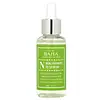What's inside
What's inside
 Key Ingredients
Key Ingredients

 Benefits
Benefits

 Concerns
Concerns

No concerns
 Ingredients Side-by-side
Ingredients Side-by-side

Aloe Barbadensis Leaf Extract
EmollientPropanediol
SolventNiacinamide
SmoothingBetaine
HumectantGlycerin
Humectant1,2-Hexanediol
Skin ConditioningZinc PCA
HumectantSodium Hyaluronate
HumectantAllantoin
Skin ConditioningDipotassium Glycyrrhizate
HumectantPanthenol
Skin ConditioningCamellia Sinensis Leaf Extract
AntimicrobialSambucus Nigra Flower Extract
RefreshingMomordica Charantia Fruit Extract
Skin ConditioningLeontopodium Alpinum Extract
Skin ConditioningWater
Skin ConditioningNiacinamide
SmoothingButylene Glycol
HumectantPropylene Glycol
HumectantPEG/PPG-14/7 Dimethyl Ether
Skin ConditioningCentella Asiatica Extract
CleansingGentiana Scabra Root Extract
Skin ConditioningAvena Sativa Kernel Extract
AbrasiveYeast Extract
Skin ConditioningCrocus Sativus Flower Extract
MaskingAlpha-Arbutin
AntioxidantCeramide NP
Skin ConditioningAvena Sativa Kernel Oil
Skin ConditioningSphingolipids
EmollientCeramide As
Skin ConditioningCeramide AP
Skin ConditioningCeramide Ns
Skin ConditioningCeramide Ng
Skin Conditioning1,2-Hexanediol
Skin ConditioningBis-PEG-18 Methyl Ether Dimethyl Silane
EmollientSodium Polyacryloyldimethyl Taurate
Emulsion StabilisingAllantoin
Skin ConditioningHydrogenated Lecithin
EmulsifyingAcrylates/C10-30 Alkyl Acrylate Crosspolymer
Emulsion StabilisingPentylene Glycol
Skin ConditioningIsohexadecane
EmollientTranexamic Acid
AstringentFructose
HumectantAminomethyl Propanol
BufferingPropanediol
SolventSodium Hyaluronate
HumectantDisodium EDTA
PEG-7 Glyceryl Cocoate
EmulsifyingPhosphatidylcholine
EmulsifyingPhytosterols
Skin ConditioningSodium Stearoyl Glutamate
CleansingHydroxyacetophenone
AntioxidantParfum
MaskingCaprylhydroxamic Acid
Soy Amino Acids
Skin ConditioningPhenoxyethanol
PreservativeChlorphenesin
AntimicrobialEthylhexylglycerin
Skin ConditioningWater, Niacinamide, Butylene Glycol, Propylene Glycol, PEG/PPG-14/7 Dimethyl Ether, Centella Asiatica Extract, Gentiana Scabra Root Extract, Avena Sativa Kernel Extract, Yeast Extract, Crocus Sativus Flower Extract, Alpha-Arbutin, Ceramide NP, Avena Sativa Kernel Oil, Sphingolipids, Ceramide As, Ceramide AP, Ceramide Ns, Ceramide Ng, 1,2-Hexanediol, Bis-PEG-18 Methyl Ether Dimethyl Silane, Sodium Polyacryloyldimethyl Taurate, Allantoin, Hydrogenated Lecithin, Acrylates/C10-30 Alkyl Acrylate Crosspolymer, Pentylene Glycol, Isohexadecane, Tranexamic Acid, Fructose, Aminomethyl Propanol, Propanediol, Sodium Hyaluronate, Disodium EDTA, PEG-7 Glyceryl Cocoate, Phosphatidylcholine, Phytosterols, Sodium Stearoyl Glutamate, Hydroxyacetophenone, Parfum, Caprylhydroxamic Acid, Soy Amino Acids, Phenoxyethanol, Chlorphenesin, Ethylhexylglycerin
 Reviews
Reviews

Ingredients Explained
These ingredients are found in both products.
Ingredients higher up in an ingredient list are typically present in a larger amount.
1,2-Hexanediol is a synthetic liquid and another multi-functional powerhouse.
It is a:
- Humectant, drawing moisture into the skin
- Emollient, helping to soften skin
- Solvent, dispersing and stabilizing formulas
- Preservative booster, enhancing the antimicrobial activity of other preservatives
Allantoin is a soothing ingredient known for its protective and moisturizingg properties. Because of this, it is often added to products with strong active ingredients.
Studies show higher concentrations of this ingredient can promote wound healing.
Though it can be derived from the comfrey plant, allantoin is produced synthetically for cosmetic products to ensure purity.
Learn more about AllantoinNiacinamide is a multitasking form of vitamin B3 that strengthens the skin barrier, reduces pores and dark spots, regulates oil, and improves signs of aging.
And the best part? It's gentle and well-tolerated by most skin types, including sensitive and reactive skin.
You might have heard of "niacin flush", or the reddening of skin that causes itchiness. Niacinamide has not been found to cause this.
In very rare cases, some individuals may not be able to tolerate niacinamide at all or experience an allergic reaction to it.
If you are experiencing flaking, irritation, and dryness with this ingredient, be sure to double check all your products as this ingredient can be found in all categories of skincare.
When incorporating niacinamide into your routine, look out for concentration amounts. Typically, 5% niacinamide provides benefits such as fading dark spots. However, if you have sensitive skin, it is better to begin with a smaller concentration.
When you apply niacinamide to your skin, your body converts it into nicotinamide adenine dinucleotide (NAD). NAD is an essential coenzyme that is already found in your cells as "fuel" and powers countless biological processes.
In your skin, NAD helps repair cell damage, produce new healthy cells, support collagen production, strengthen the skin barrier, and fight environmental stressors (like UV and pollution).
Our natural NAD levels start to decline with age, leading to slower skin repair, visible aging, and a weaker skin barrier. By providing your skin niacinamide, you're recharging your skin's NAD levels. This leads to stronger, healthier, and younger looking skin.
Another name for vitamin B3 is nicotinamide. This vitamin is water-soluble and our bodies don't store it. We obtain Vitamin B3 from either food or skincare. Meat, fish, wheat, yeast, and leafy greens contain vitamin B3.
The type of niacinamide used in skincare is synthetically created.
Learn more about NiacinamidePropanediol is an all-star ingredient. It softens, hydrates, and smooths the skin.
It’s often used to:
Propanediol is not likely to cause sensitivity and considered safe to use. It is derived from corn or petroleum with a clear color and no scent.
Learn more about PropanediolSodium Hyaluronate is hyaluronic acid's salt form. It is commonly derived from the sodium salt of hyaluronic acid.
Like hyaluronic acid, it is great at holding water and acts as a humectant. This makes it a great skin hydrating ingredient.
Sodium Hyaluronate is naturally occurring in our bodies and is mostly found in eye fluid and joints.
These are some other common types of Hyaluronic Acid:
Learn more about Sodium Hyaluronate